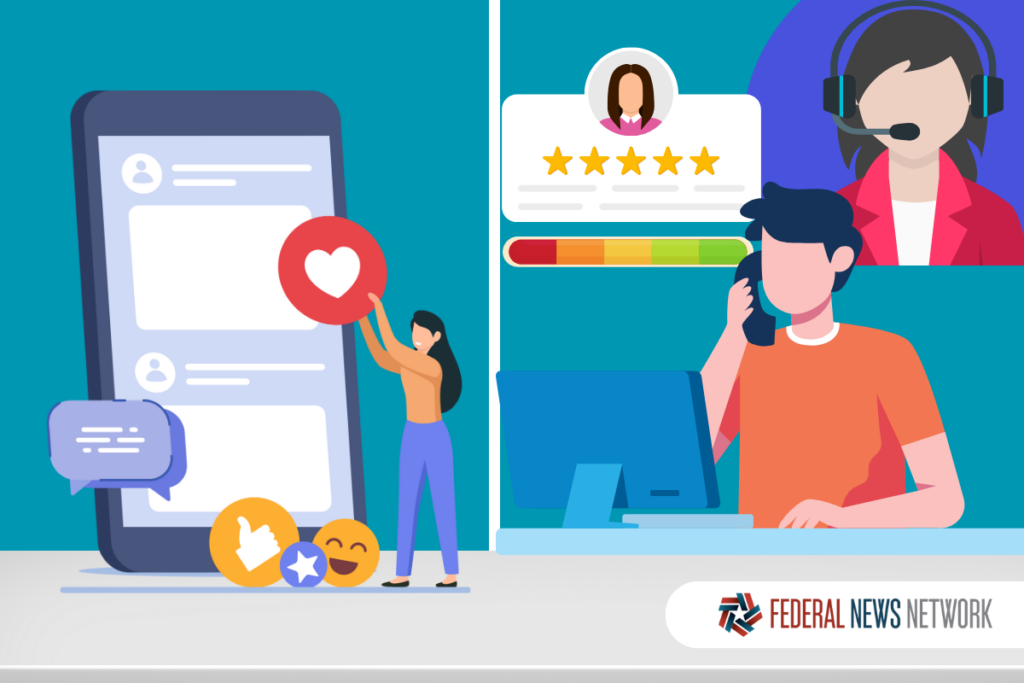
With its contracts, the General Services Administration supplies information technology products and policy to much of government. It also has to take care of itself. Officials want to make sure the GSA’s own tech staff has a good work experience. That’s in part the responsibility of its associate chief information officer Erika Dinnie, who joined the Federal Drive with Tom Temin.
Erika Dinnie We have learned that employees really value the same experience that they have at home in the office. And what that means is their ability to choose the tools that they want to get the job done. Their seamless connectivity and ability to really have a seamless experience similar to what they have in the home. And if we’re not providing that, we get a lot of feedback regarding it’s much easier to do this at home versus in the office and why would we come into the office? And so that’s a component of it, but also just the looking at IT and the ability to use IT as a lever to effect end to end the lifecycle experience of an employee and their happiness, overall happiness. And I think we’ve overlooked it for many years and we’re starting to focus on before they even walk in the office, they get a laptop and it really sets the stage for that experience from before day one. And so that’s what we’re looking to do.
Tom Temin And post-pandemic, of course, there are many tools that are commonly used that were not used earlier and they have different experiences. And if someone is used to Zoom, well, Teams can be weird or vice versa. And you’ve had some experience trying to rationalize and abstract that problem of the different tools, not just for video conferencing, but for, say, personal productivity, Google versus Microsoft. How do you resolve all that? For a large organization?
Erika Dinnie It was difficult. It really forced us to stretch and to think differently as an organization and and really create a new skill sets within our team. It opened us up to listening more to — we call them the customer — but our employees, we had to listen to what they really needed and a lot of feedback we would default to, ‘well, we don’t offer teams because we’re a Google shop.’ And again, like I said, it just really stretched us to open up to new possibilities. It forced us to compete in different spaces and then started to look at delivering flexibility and choice versus just a standard enterprise offering. And we have found, believe it or not, that it’s cheaper, our employees are more satisfied and we’re better able to deliver our mission, our metrics are pretty good, and I think getting better, by focusing on flexibility in choice versus one-enterprise-solution-fits-all.
Tom Temin And on that point of employees being satisfied, GSA does a lot of pulse surveys. I think you recently said that you really do a lot of them. And what do you do with respect to IT satisfaction, OK-ness with the tools and so forth. And what kind of feedback do you get and what changes have you made maybe because of a pulse survey?
Erika Dinnie Yeah, we do so many surveys and those pulse surveys though are a barometer for different pieces of the organization that we’re measuring for. So some might be return to facilities, some might be the tools that you have to do your job and some might be work life balance, for example. So we do look at them differently. My approach is to get beyond customer satisfaction. So that’s great. We have a 90% customer satisfaction. I’m really focused on the 10% and what is that 10% saying? And so because I often feel that — I refer to these metrics, sometimes as watermelon metrics — and they’re always green on the outside. But when you dig in a little bit there, you find out they’re red and you talk to people and you get a different, from anecdotal information, you’re getting a different perspective. And so I am often looking at a non-response bias. So, for example, if I’m looking at a survey and it’s 90% satisfaction, I look at who didn’t respond. And sometimes that’s upwards of 75% of the organization, maybe, maybe 50%. So trying to dig into the 50% that didn’t respond. And then how do we get information from there?
Tom Temin And by the way, on that topic of remote and different tools, what’s your best advice, I should say, for organizations dealing with the cybersecurity issues of people working remotely at home on whatever particular ISP they might have and whatever router they might have?
Erika Dinnie Well, my advice is security first. You have to learn to incorporate when you’re delivering IT in this day and age, it is security first. And so working with a partnership with your [chief information security officer] organization and equipping and educating your employees and it used to be security was done in a bit of a vacuum and employees were just not aware and didn’t understand. We’ve brought them along and they’ve bought into the idea. They understand why it’s important. They understand why their tools need to be secure. We’ve locked down cell phones, for example. There’s so many things that you can’t do on your government issued computer that you used to do. And we’re not getting any pushback. And I think it’s because of the education and bringing them along and tying it to, again, to our mission of we cannot support other government agencies if we’re not in a secure environment. And I think that they understand that now.
Tom Temin And a good encrypted VPN takes care of whatever Verizon or T-Mobile or whatever is coming into the house.
Erika Dinnie Yeah, well, we have embraced a zero trust posture and so we no longer have to do VPN and everyone has direct access to the Internet. We’ve moved that boundary, that security boundary from a perimeter or a base right down to the end unit device. And that has really made a difference as well. So again, it’s more secure, but it’s actually easier and a little bit more cost effective to deliver. So it’s a bonus and a value add. And I think most employees are excited that they don’t have to go through a VPN and wait 12 minutes or sometimes downloading data used to take a quite a long time and it no longer does. So it’s been beneficial to them.
Tom Temin We’re speaking with Erika Dinnie. She’s the associate chief information officer at the General Services Administration. And GSA and other federal agencies deal with something that sometimes corporations don’t deal with, and that is people in very remote areas. And sometimes there’s not even good ground based phone service, let alone cell service. And you’ve made some moves to make sure that there’s space service for people that are very remote. Tell us more about that.
Erika Dinnie Absolutely. Yes. And again, we had to be comfortable looking, being leaders in technology and looking for viable alternatives and using contracts to leverage, again, flexibility. And so the ability, we’ve tried a couple of different services, for example. And if they’re not working, then we have to be able to look at alternate venues. And this is one of the areas that we’ve looked into is low orbit satellite solutions. And that has been very helpful for some of our areas that do not have terrestrial based services available. And it’s taking them from an operating posture, which was probably fine back in the 1980s to today, where they again, they have that direct access and it’s in seconds and they are having as good of as experience as someone sitting in a Washington, D.C. Office. And so that’s been a terrific bonus.
Tom Temin And the satellite services themselves are getting more ubiquitous and much more capable, too, aren’t they?
Erika Dinnie Absolutely. Yeah, absolutely. And like I said, we used to have such a differential when you would do surveys, for example. And if you slice and dice the data, the difference between regional office buildings and field office locations, you just had a wide disparity between satisfaction and the ability to connect. And we could measure that in seconds and minutes in some cases, and we don’t have that anymore. So yeah.
Tom Temin And moving on, you spoke about the issue of people that may not be all that technically adept and the whole world is not us. And calling the helpdesk for doing routine Windows types of functions, creating desktop folders, this kind of thing, which is routine for most people, but not everyone. And you had kind of a creative way of getting that person off the helpdesk for not real helpdesk issues.
Erika Dinnie Yeah, we’re really concerned about the different levels of not everybody comes to technology with the same expertise, and so we are looking at using AI or even maybe some robotic robotic processing or alarm capabilities to define categories of employees that are kind of low, middle to high sophistication in IT and targeting our communications, targeting our support and arming. When a service desk our answer is a phone call and they’re armed with information that I’m working with somebody that that really doesn’t understand it very well or someone that has a very high sophistication. They can tailor how they’re talking to that individual and they can tailor some of the remedies that they need to do with that person.
Tom Temin So, in other words, a buddy type of system.
Erika Dinnie Yes, absolutely. Yes.
Tom Temin And also, I guess the help desk or the online help that you offer has to be highly tailored to the systems you’re actually using, because how often have we had that experience where you go to the Internet to find out how to do something on an application? And then three steps in well, that button isn’t there, that the search set is there. And so maybe on some systems it’s there, but not on yours.
Erika Dinnie Yeah. In one of the areas that we are exploring and we’ve implemented as well are these little vignette videos and knowledge based articles and again, different streams of information for people who learn differently. And so if you’re used to a one minute and 30 second video, we have that for you. But if you like to read three to 10 pages of information on the application that you’re trying to trying to learn, you have that ability as well.
Tom Temin And what you have learned as GSA’s deputy CIO and some of these issues of dealing with employee situations and personas, are you able to, as the government wide provider, which is not your responsibility, but have you been able to migrate what you’ve learned out to those parts of GSA that then go out to the rest of the government?
Erika Dinnie Absolutely. We sit on the CIO Council, we’re on the subcommittee councils as well. We certainly share information on a daily basis, particularly around our zero trust transformation. And we have really shared that experience, all of our playbooks, and we talk to people all the time that are looking to do something similar. Along with we’ve been able to transform our our network architecture from hub-and-spoke to a streamlined direct access and and it’s been terrific. But I would say too, we learn from other agencies, we’re always seeking to learn what they’re doing. How are they affecting IT experience and what tools that they’re bringing to the table as well.
Copyright
© 2024 Federal News Network. All rights reserved. This website is not intended for users located within the European Economic Area.







